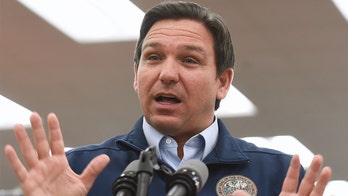Will Republicans retain control of the Senate next year?
‘Special Report’ anchor Bret Baier examines key state races on ‘Bill Hemmer Reports.’
There are lots of ways to break ties in sports.
Soccer eventually heads to a penalty kick shootout.
The NHL eliminated ties at the end of the 2004 season. Teams now play a three-on-three overtime. The squads advance to a shootout if the match remains tied after the extra period.
Major League Baseball outraged purists over the summer with an experimental rule change. Games still go to extra innings. But from the tenth on, each half-inning begins with a designated runner at second base. This innovation drives some in the sports world bonkers.
But what happens if there’s a tie in the Senate? Such a scenario is certainly a possibility this fall.
It’s even possible the Senate races aren’t settled until next year. You heard that right. Jan. 5. Two days after the 117th Congress convenes on January 3, 2021
Both of Georgia’s Senate races could go to a runoff. Georgia law mandates a runoff if neither candidate scores a majority. Incumbent Sen. David Perdue, R-Ga., is locked in a battle with Democrat Jon Ossoff.
There’s a special election, too. Sen. Kelly Loeffler, R-Ga., faces Rep. Doug Collins, R-Ga., and Democrat Raphael Warnock.
CLICK HERE FOR COMPLETE COVERAGE OF 2020 SENATE RACES
So which party controls the Senate if there’s a tie? 50-50?
It’s a misnomer that a tied Senate automatically means the party of the president claims the “majority.” The vice president serves as president of the Senate and can vote to break ties – if he or she wants to do so. Keep in mind that by rule, a tie vote fails in the Senate. So, there are occasions where a vice president might not cast a ballot at all if the vote on a given issue goes the way the administration wants.
No written rule
But it’s not written down anywhere that the party affiliation of the vice president decrees which party is in charge in an equally divided Senate.
This wasn’t an issue until 1881. The Senate was initially tied 37-37 with two independents. Sen. David Davis, I-Ill., ultimately announced he would throw his support to the Democrats. That left the GOP to pressure Sen. William Mahone, I-Va., to side with them. Mahone did, effectively leveling the Senate at 38 votes apiece.
There was no such thing as a majority or minority leader in the Senate back then. Those positions didn’t emerge until the early 20th century. But Mahone’s decision to vote with the GOP meant Republicans kind of controlled of the Senate. Voters had just elected Republican President James Garfield. Therefore, Vice President Chester Alan Arthur could break ties on behalf of the GOP. The new Garfield administration sent bouquets of flowers to Mahone, displaying them prominently on the senator’s desk as a token of gratitude.
Arthur broke three ties in his capacity as Senate kingmaker in an otherwise deadlocked Senate. In the spring of 1881, both of New York’s Republican senators resigned in protest over a squabble over appointments. State legislatures selected senators in those days. The New York senators believed their state would reappoint them quickly. But that didn’t happen. That meant Democrats suddenly had a two-seat advantage in the middle of the Congress.
The circumstances demanded deal-making since the resignations abruptly propelled Democrats to the majority. They reached a settlement. Republicans would still chair committees but Democrats were in charge of Senate officers and other posts.
GOP SENATE CANDIDATE, A WOUNDED VET, BLASTS DEM CLAIM HE'D END PREEXISTING CONDITIONS COVERAGE
Senate control shifted later that year. Garfield died after Charles Guiteau shot him. Garfield hung on for several months but ultimately passed away due to questionable medical decisions by his doctors. Arthur became president – but lacked a vice president. So, the aforementioned David Davis became president pro tempore of the Senate.
Davis decreed that Republicans should control the Senate – even though they had fewer seats. Davis argued Republicans should be in charge since the party controlled the presidency and the House of Representatives.
Senate convulsions
There have never been majority/minority convulsions like there were in the Senate during the 83rd Congress from 1953 to 1955.
Republicans initially had the majority after the 1952 midterm elections: 48 Republicans, 47 Democrats and Sen. Wayne Morse, I-Ore. Morse started as a Republican but switched to an independent. Morse later aligned with the Democrats.
But things were just getting started. Nine senators died over the course of the two-year Congress. The Senate “majority” in the 83rd Congress shifted a grand total of 12 times between Republicans and Democrats – or was tied.
The Congress began with Republicans in the majority. Then it broke to even. Then Democrats got control. Then back to a tie. Reverted to Democratic control. Switched back to even. Then Republicans got the majority. Then back to a deadlock. Republicans then had the advantage. Then Democrats. Then back to a tie. Finally, Democrats had the majority.
All in a single two-year period.
Just because a party has a de facto majority doesn’t mean it truly enjoys the majority.
Republicans lacked the outright majority at various points during that Congress. But the GOP operated as the majority – even when the math wasn’t in the GOP’s favor. Senate Majority Leader Robert Taft, R-Ohio, died, giving way to Senate Majority Leader William Knowland, R-Calif.
But, it probably should have been Senate Majority Leader Lyndon Johnson, D-Texas.
Few strode through the Senate doors who understood politics better than Johnson. Even though LBJ eventually had the numbers on his side, he decided not to press the issue. After all, the way Johnson thought, it may be better for Democrats to operate in the minority – even though they had the majority.
VIRGINIA SENATE DEBATE SEES WARNER, GADE CLASH ON TRUMP, RACE, HEALTH CARE
The phrase “all the power, none of the responsibility” comes to mind.
Knowland lamented his political hand during one notable exchange.
“I have the responsibilities of being the majority leader in this body without having a majority,” complained Knowland.
Johnson had none of it.
“If anyone has more problems than a majority leader with a minority, it’s a minority leader with a majority,” replied Johnson.
Political backstabbing of the most vile order eventually prompted Sen. Lester Hunt, D-Wyo., to shoot himself inside what is now the Russell Senate Office Building. Hunt’s suicide meant the Senate was back to even at 47 Democrats, 47 Republicans and one independent.
Everyone recalls the dispute over Florida in the 2000 presidential election. But few remember that the Senate deadlocked at 50-50.
Vice President Dick Cheney would break ties in a split Senate after the Supreme Court ruled in favor of President George W. Bush. But again, nowhere is it written that Senate control magically goes to the President’s party if things are tied.
Former Senate majority leaders Trent Lott, R-Miss., and Tom Daschle, D-S.D., engineered a bipartisan power-sharing arrangement. Lott was majority leader at the beginning of the Congress. But Daschle had the right to call up bills. And, Republicans and Democrats had equal representation on committees.
Daschle had the foresight to build into the deal a proviso which nullified the pact if either side acquired a clear majority during that Congress.
CLICK HERE TO GET THE FOX NEWS APP
Later in the Congress, the late Sen. Jim Jeffords, I-Vt. defected from the Republican Party, deciding to associate with the Democrats. Democrats suddenly had the edge, 51-49. It also meant that Daschle was outright majority leader, relegating Lott to minority status.
A draw in the Senate contests isn’t out of the question this time around.
A toxified environment now shrouds the Senate. It’s augmented by the confirmation of Supreme Court Justice Amy Coney Barrett. As a result, it’s hard to see how Senate Majority Leader Mitch McConnell, R-Ky., and Minority Leader Chuck Schumer, D-N.Y., could forge any sort of power sharing accord if the Senate is deadlocked in 2021.








